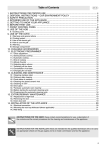Download Smeg A2C-6 cooker
Transcript
Contents 1. INSTRUCTIONS FOR SAFE AND PROPER USE _____________________ 36 2. INSTALLATION OF THE APPLIANCE ______________________________ 38 3. DESCRIPTION OF CONTROLS___________________________________ 42 4. USE OF THE COOKING HOB ____________________________________ 49 5. USE OF THE OVENS ___________________________________________ 51 6. AVAILABLE ACCESSORIES _____________________________________ 53 7. COOKING HINTS ______________________________________________ 54 8. CLEANING AND MAINTENANCE _________________________________ 61 9. EXTRAORDINARY MAINTENANCE _______________________________ 66 THESE INSTRUCTIONS ARE VALID ONLY FOR END USER COUNTRIES WHOSE IDENTIFICATION SYMBOLS APPEAR ON THE COVER OF THIS MANUAL. INSTRUCTIONS FOR THE INSTALLER: these are intended for the qualified technician who must install the appliance, set it functioning and carry out an inspection test. INSTRUCTIONS FOR THE USER: these contain user advice, description of the commands and the correct procedures for cleaning and maintenance of the appliance. 35 Introduction 1. INSTRUCTIONS FOR SAFE AND PROPER USE THIS MANUAL IS AN INTEGRAL PART OF THE APPLIANCE AND THEREFORE MUST BE KEPT IN ITS ENTIRETY AND IN AN ACCESSIBLE PLACE FOR THE WHOLE WORKING LIFE OF THE COOKER. WE ADVISE READING THIS MANUAL AND ALL THE INSTRUCTIONS THEREIN BEFORE USING THE COOKER. INSTALLATION MUST BE CARRIED OUT BY QUALIFIED PERSONNEL IN ACCORDANCE WITH THE REGULATIONS IN FORCE. THIS APPLIANCE IS INTENDED FOR DOMESTIC USES AND CONFORMS TO CURRENT REGULATIONS IN FORCE. THE APPLIANCE HAS BEEN BUILT TO CARRY OUT THE FOLLOWING FUNCTIONS: COOKING AND HEATING-UP OF FOOD. ALL OTHER USES ARE CONSIDERED IMPROPER. THE MANUFACTURER DECLINES ALL RESPONSIBILITY FOR IMPROPER USE. DO NOT LEAVE THE PACKING IN THE HOME ENVIRONMENT. SEPARATE THE VARIOUS WASTE MATERIALS AND TAKE THEM TO THE NEAREST SPECIAL GARBAGE COLLECTION CENTRE. IT IS OBLIGATORY FOR THE ELECTRICAL SYSTEM TO BE GROUNDED ACCORDING TO THE METHODS REQUIRED BY SAFETY RULES. THE PLUG TO BE CONNECTED TO THE POWER CABLE AND THE SOCKET MUST BE THE SAME TYPE AND MUST CONFORM TO CURRENT REGULATIONS. THE SOCKET MUST BE ACCESSIBLE AFTER THE APPLIANCE HAS BEEN BUILT IN. NEVER UNPLUG BY PULLING ON THE CABLE. IMMEDIATELY AFTER INSTALLATION CARRY OUT A BRIEF INSPECTION TEST OF THE APPLIANCE, FOLLOWING THE INSTRUCTIONS BELOW. SHOULD THE APPLIANCE NOT FUNCTION, DISCONNECT IT FROM THE SUPPLY AND CALL THE NEAREST TECHNICAL ASSISTANCE CENTRE. NEVER ATTEMPT TO REPAIR THE APPLIANCE. ALWAYS CHECK THAT THE CONTROL KNOBS ARE IN THE POSITION 0 (OFF) WHEN YOU FINISH USING THE HOB. NEVER PUT INFLAMMABLE OBJECTS INTO AN OVEN: IF THEY CATCH FIRE THEY COULD CAUSE A FIRE IN THE HOME. 36 Introduction THE I.D. PLATE WITH TECHNICAL DATA, REGISTRATION NUMBER AND BRAND NAME IS POSITIONED VISIBLY IN THE STORAGE COMPARTMENT. THE PLATE MUST NOT BE REMOVED. DURING USE THE APPLIANCE BECOMES VERY HOT. TAKE CARE NOT TO TOUCH THE HEATING ELEMENTS INSIDE THE OVEN. DO NOT PUT PANS WITHOUT PERFECTLY SMOOTH AND FLAT BOTTOMS ON THE COOKING HOB GRIDS. DO NOT INSTALL THIS APPLIANCE ON A RAISED PLATFORM ATTENTION: IN CASE OF A CRACK BEING DETECTED IN THE GLAZED CERAMIC HOB, IMMEDIATELY DISCONNECT FROM MAINS AND CONTACT THE NEAREST SERVICING CENTRE. THE USE OF THIS APPLIANCE IS NOT PERMITTED TO PEOPLE (INCLUDING CHILDREN) OF REDUCED PHYSICAL AND MENTAL ABILITY, OR LACKING IN EXPERIENCE IN THE USE OF ELECTRICAL APPLIANCES, UNLESS THEY ARE SUPERVISED OR INSTRUCTED BY ADULTS OR PEOPLE RESPONSIBLE FOR THEIR SAFETY. THIS APPLIANCE IS MARKED ACCORDING TO THE EUROPEAN DIRECTIVE 2002/96/EC ON WASTE ELECTRICAL AND ELECTRONIC EQUIPMENT (WEEE). THIS GUIDELINE IS THE FRAME OF A EUROPEAN-WIDE VALIDITY OF RETURN AND RECYCLING ON WASTE ELECTRICAL AND ELECTRONIC EQUIPMENT. BEFORE THE APPLIANCE IS PUT INTO OPERATION, ALL THE LABELS AND PROTECTIVE FILMS APPLIED INSIDE OR OUTSIDE MUST BE REMOVED. The manufacturer declines all responsibility for damage to persons or things caused by non-observance of the above prescriptions or by interference with any part of the appliance or by the use of non-original spares. 37 Instructions for the installer 2. INSTALLATION OF THE APPLIANCE It can be placed against walls higher than the hob, at a distance of at least 50 mm from the side of the appliance, as shown in the drawings A and B relating to the installation classes. Wall units or extractor hoods located above the hob must be at least 750 mm away from it. A B Built-in appliance Free-standing installation 2.1 Electrical connection Make sure that the power line voltage matches the specifications indicated on the rating plate located inside the storage compartment. This rating plate must never be removed. On the power line, install an omnipolar cut-off device with contact cut-off distance greater than or equal to 3 mm, located in an easily accessible position near the unit. 38 Instructions for the installer The appliance is fitted with a terminal board at the rear for electrical connections (see following diagram). To access, remove the rear cover. For operation on 380-415V3N∼: use an H05V2V2-F-type five-core cable (5 x 2.5 mm2). For operation on 220-240V∼: use an H05V2V2-F-type three-core cable (3 x 6 mm2). The cable end to be connected to the appliance must be provided with an ground wire (yellow-green) at least 20 mm longer. 39 Instructions for the installer Complete wiring up to power supply with an appropriately rated five-core plug (see data plate) or, in case of operation from a 220-240V∼ power supply, with a three-core plug. Make sure that plug and wall socket are of the same type and are in conformity with regulations in force. Make sure that the appliance is properly earthed. Before powering, check that the power line is properly earthed. Avoid using adapters or shunters. The manufacturer declines all responsibility for damage to persons or things caused by non-observance of the above prescriptions or by interference with any part of the appliance. 2.2 • • Mounting the rear top upstand Position the upstand above the top, taking care to align holes A with holes B. Secure the upstand to the top by tightening screws C. Warning: the rear upstand (or optional back panel) must be fitted to prevent the rear wall from overheating. 2.3 Positioning and levelling of the appliance Having carried out the electricity hook-up, level the appliance using the four adjustable legs. 40 Instructions for the installer 2.4 Instruction for wall fixing (only on some models) 1) 2) 3) 4) A Fix the screw to the wall and hook the chain (B); Hook the chain to the hole positioned at the rear of the cooker by the gas pipe (A); Once the chain is in position, push the cooker against the wall; The height of the screw hole from floor level must not exceed 800 mm (C). B C 41 Instructions for the user 3. DESCRIPTION OF CONTROLS 3.1 Front control panel All the cooker controls and commands are on the front panel. The user has only to press the central key for 1/2 seconds to enable use of the oven on first use or after a power blackout. (only for the main oven) DESCRIPTION OF SYMBOLS FRONT LEFT-HAND COOKING ZONE REAR LEFT-HAND COOKING ZONE REAR RIGHT-HAND COOKING ZONE FRONT RIGHT-HAND COOKING ZONE BARBECUE ELEMENT 42 MAIN OVEN THERMOSTAT AUXILIARY OVEN THERMOSTAT MAIN OVEN FUNCTIONS AUXILIARY OVEN FUNCTIONS Instructions for the user COOKING HOB CONTROL KNOB Standard heating The circle next to each knob indicates the cooking zone it controls. To heat, push and turn the knob to the desired position (1 to 9). Adjustment is continuous so that the appliance also operates at any intermediate value. To turn off, return the knob to 0. Double heating The circle next to each knob indicates the cooking zone it controls. To heat the inner cooking zone, push and turn the knob to the desired position (1 to 9). To heat both the inner and outer cooking zones, turn the knob to ; and then release. The knob will thus return to 9. To adjust heating intensity, rotate the knob anticlockwise to the desired position. To return to heating of the inner cooking zone only, set the knob back to 0 and then turn to the desired position (1 to 9). To switch off, return knob to 0. BARBECUE ELEMENT POWER REGULATOR KNOB This knob allows adjustment of the power of the barbecue griddle on the hob. Set the knob on any position from “1” to “9” to turn on the heating element. The pilot light illuminates to indicate that the element is in operation. To switch off the element, turn the knob to “0”. CAUTION: after it has been in operation for some time, the plate will remain hot even after the element has been switched off: keep children at a safe distance. 43 Instructions for the user THERMOSTAT KNOB (OVENS) Selection of cooking temperature is carried out by turning the knob clockwise to the required temperature, between 50° and 250°C. The tell-tale light comes on to indicate that the oven is warming up. When it goes out it means that the required temperature has been reached. Regular flashing means that oven temperature is being constantly maintained at the programmed level. Main oven Auxiliary oven FUNCTION SWITCH KNOB (OVENS) Turn the knob to select from the following functions: Main oven MAIN OVEN AUXILIARY OVEN NO FUNCTION SET NO FUNCTION SET UPPER AND LOWER HEATING ELEMENT UPPER AND LOWER HEATING ELEMENT UPPER AND LOWER HEATING ELEMENT + VENTILATION UPPER HEATING ELEMENT GRILL ELEMENT LOWER HEATING ELEMENT GRILL ELEMENT + VENTILATION GRILL ELEMENT LOWER HEATING ELEMENT + VENTILATION UPPER HEATING ELEMENT + GRILL LOWER HEATING ELEMENT + VENTILATED HEATING ELEMENT GRILL + SPIT ELEMENT VENTILATED HEATING ELEMENT + VENTILATION DEFROSTING 44 Auxiliary oven Instructions for the user 3.2 Electronic Analogue Clock The instructions provided apply to the main oven only. LIST OF FUNCTIONS MINUTE-MINDER BUTTON AUTOMATIC SWITCH-OFF TIMING BUTTON TIME SETTING AND RESET VALUE DECREASE BUTTON VALUE INCREASE BUTTON 3.2.1 Setting the time When the oven is used for the first time, or after a power blackout, the display flashes on and off at regular intervals. Press the key for 1/2 seconds to stop the display flashing and start setting of the current time. Press the value modification keys or to increase or decrease by one minute for each time a key is pressed. Press one of the two value modification keys until the current time appears. The clock will start from the time set 6/7 seconds after the last key is pressed. At the end of each programmed cooking operation, the clock gives 8 beeps, repeated 3/4 times at intervals of about 1 and a half minutes. The beeps can be stopped at any moment by pressing any key. 45 Instructions for the user 3.2.2 Minute-minder This function does not stop cooking but just triggers the beeps. key is pressed the display When the illuminates, appearing as shown in figure 1; Press the or keys within 6/7 seconds to set the minute-minder. Whenever a key is pressed, 1 outside segment, representing 1 cooking minute will light up (figure 2 shows 10 cooking minutes). The countdown will start 6/7 seconds after the last key is pressed; at the end of it, you will hear the beeps. During cooking with countdown, the current time can be displayed by pressing the key once; press again to return to the minuteminder display. 2 At the end of the countdown, the oven has to be switched off by hand, by turning the thermostat to 0. 46 1 Instructions for the user 3.2.3 Programming Cooking duration time: the 2nd button can be used to set the cooking time. Before setting it, turn the thermostat to the cooking temperature of choice and the function selector knob to any setting. To set the cooking time, proceed as follows: - - - - Press the key for 1/2 seconds; the pointer will move to position 12 (Fig. 1). Use the and keys to set the cooking time; key is pressed, 1 minute will be whenever the added to the cooking time, and every 12 minutes a 1 new inside segment will light up (figure 2 shows a cooking time of 1 hour). Once the required time has been set, cooking will start about 6 seconds after the last time the or . key is pressed. Once cooking has started, the display will show the current time, represented by the constantly on 2 segments, and the minutes left until cooking finishes, represented by the flashing segments (every flashing segments indicates 12 minutes of cooking time left). When the end of the cooking time is reached, the timer will switch off the oven heating elements, the beeps will start and the numbers on the dial will flash. The cooking time can also be reset by deleting the program set; for 1 or 2 seconds will delete the time set pressing the central key and the oven will have to be switched off by hand. Caution: cooking times of more than 6 hours cannot be set. 47 Instructions for the user Cooking start: as well as setting a cooking duration time, the user can also set the cooking start time (up to 12 hours after the current time). To set the cooking start/end time, proceed as follows. - Set the cooking duration time as described in the previous point. or keys are Within 6/7 seconds after the last time the key to set the cooking start time. The display pressed, press the will show the current time with the inside segments indicating the and keys to set the cooking end time illuminated. Use the cooking start time. 6/7 seconds after the last time a key is pressed, the display will show the current time and the cooking start and end times, indicated by the illuminated inside segments. The segments on the display will be constantly on until the current time is the same as the cooking start time; as soon as the current time reaches the cooking start time set, all the inside segments will start to flash, indicating that the oven has started cooking. When the end of the cooking time is reached, the timer will switch off the oven heating elements, the beeps will start and the numbers on the dial will flash. To reset the entire program set, keep the central key pressed for 1 or 2 seconds: if cooking has already started the oven will have to be switched off by hand. The image on the right shows an example of programming: the current time is 7.06 and cooking is programmed to start at 8 o'clock and finish at 9. At 8 o'clock, the inside segments between 8 and 9 will start to flash and the hour pointer will remain still. Caution: for the oven to start cooking after the programming procedure just described, the thermostat must be properly set on the temperature required. 3.2.4 "DEMO" Function Models with analogue/digital programmer feature a "DEMO" function which deactivates the heating elements while leaving the other functions unchanged. To activate it, simply press the , , and keys and keep them held down for 3-4 seconds. A confirmation buzzer will inform the user that the function is active. When the “DEMO” function is active, the number 6 on the clock flashes at regular intervals. To deactivate it, simply repeat the same procedure. 48 Instructions for the user 4. USE OF THE COOKING HOB 4.1 Cooking zones The appliance features 4 cooking zones of different diameter and power. Their position is clearly indicated by circles and the heat given off is defined by the markings on the glass surface. The 4 cooking zones are of the HIGH-LIGHT type and come on after a few seconds of being activated. Heating intensity can be adjusted by means of the knobs located on the front panel from a minimum setting of 1 to a maximum setting of 9. The cooking zones marked by two concentric circles ( ) and by a circle feature double heating either within the inner circle or both circles. The 4 signal lamps located between the cooking zones come on when the temperature of one or more of the heating zones exceeds 60°C. The lamps go off upon temperature dropping to below approximately 60°C. When using for the first time, it is advisable to heat up the cooking hob to its maximum temperature for enough time so as to burn off any possible oily manufacturing residues, the smell of which could otherwise be absorbed by the food. For best results and energy saving, only use receptacles suitable for electric cooking: • The bottom of the receptacles must be very thick and perfectly flat; before placing on the cooking hob, make sure that it, as well as the cooking hob itself, are perfectly clean and dry. • To avoid scratching of the cooking hob, never use cast-iron receptacles or receptacles with a rough bottom. • To avoid waste of energy, make sure that the diameter of the receptacle bottom is the same as that of the circle marked on the cooking hob. 49 Instructions for the user Take care not to spill sugar or sweet mixtures on to the cooking hob when hot. Never place materials or substances which may melt (plastic or aluminium foil) on to the cooking hob. In the event, promptly switch off and remove the molten material with the scraper provided while the top is still warm to prevent it from being damaged. Failure to instantly clean the glazed ceramic hob could lead to encrustations which are impossible to remove once the hob has cooled down. Important. Beware of children in the vicinity as the signal lamps indicating residual heat are out of sight to them. In fact, even after having been turned off, the cooking hob remains hot for a certain period of time. Make sure that children never touch the cooking hob. 4.2 Cooking tips The following table shows the knob setting according to the type of food to be cooked or heated. Setting may vary depending on the amount of food and personal taste. KNOB SETTING 1 TO MELT BUTTER, CHOCOLATE, AND THE LIKE. 2-3 TO HEAT FOOD, KEEP SMALL AMOUNTS OF WATER ON THE BOIL, AND WHIP UP SAUCES WITH EGG YOLK OR BUTTER. 4-5 TO HEAT SOLID OR LIQUID FOOD, KEEP SMALL AMOUNTS OF WATER ON THE BOIL, THAW DEEP-FROZEN FOOD, COOK OMELETTES OF 2 OR 3 EGGS, FRUIT AND VEGETABLES, AND THE LIKE. 6 TO STEW MEAT, FISH AND VEGETABLES, SIMMER FOOD, MAKE JAMS, AND SO ON. 7-8 TO ROAST MEAT, FISH, STEAKS, AND LIVER; TO SAUTÉ MEAT, FISH, EGGS AND SO ON. 9 50 TYPE OF FOOD TO DEEP-FRY POTATOES, ETC AND TO QUICK-BOIL WATER. Instructions for the user 5. USE OF THE OVENS 5.1 Warnings and general advice Before using the oven for the first time, pre-heat it to maximum temperature (250°C) long enough to burn any manufacturing oily residues which could give the food a bad taste. The user has only to press the central key for 1 - 2 seconds to enable use of the oven on first use or after a power blackout. To regulate, refer to paragraph "5.2 Electronic Analogue Clock”. 5 cm To prevent any steam in the oven creating problems, open the door in two stages: half open (5 cm approx.) for 4-5 seconds and then fully open. To access food, always leave the door open as short a time as possible to prevent the temperature in the oven from falling and ruining the food. During cooking, do not cover the bottom of the oven with aluminium or tin foil and do not place pans or oven trays on it as this may damage the enamel coating. If you wish to use greaseproof paper, place it so that it will not interfere with the hot air circulation inside the oven. 5.2 Oven Light It comes on when the function switch knob is turned to any position. 5.3 Cooling fan The appliance is equipped with a cooling system, which comes into operation as soon as a cooking function is selected. This is also the case for cooking with the minute minder. Fans cause a steady outflow of air from the rear top skirtboard on the rear of the cooking hob, which may continue for a brief period of time even after the oven has been turned off. This ventilation system ensures that the temperatures on the outside of the appliance meet the standards required by the current regulations. 51 Instructions for the user 5.4 Storage compartment The storage drawer is at the bottom of the cooker, underneath the oven. For access, pull the bottom of the door. Never store inflammable materials such as rags, paper or the like. The compartment is intended only for holding the metal accessories of the range. Never open the storage compartment when the oven is on and still hot. The temperature inside may be very high. 52 Instructions for the user 6. AVAILABLE ACCESSORIES The oven features 4 support positions for plates and racks of different height. Oven rack: for cooking food on plates, small cakes, roasts or food requiring light grilling. Plate rack: for placing above plate for cooking foods that might drip. Oven plate: useful for catching fat from foods on the rack above. Pastry plate: for baking cakes, pizza and oven desserts. Roasting spit: useful for cooking chicken, sausages and anything else requiring uniform cooking over the whole surface. Only for auxiliary oven. Spit Frame: to be inserted in the guides of the auxiliary oven before using the spit. Optional accessories The bottom plinth, self-cleaning oven liners and barbecue grid can be ordered through our Authorised Service Centres. Barbecue rack: this open rack is for installation on the barbecue element instead of the aluminium plate. 53 Instructions for the user 7. COOKING HINTS In fan-assisted mode preheating should be carried out at 30/40°C above the cooking temperature. This considerably shortens cooking times and reduces power consumption, as well as giving better cooking results. Keep the oven door closed during cooking 7.1 Traditional cooking (main and auxiliary ovens) FUNCTION SWITCH THERMOSTAT SELECTOR SWITCH FROM 50° TO 250°C This traditional cooking method, in which heat comes from above and below, is suitable for cooking food on a single level. You have to preheat the oven until the set temperature is reached. Place the food in the oven only after the thermostat indicator light has turned off. very fatty meats may be put in when the oven is still cold. Put frozen meat in immediately, without waiting for it to thaw. The only precaution you need to take is to set the temperature about 20°C lower and cooking time about 1/4 longer than you would for fresh meat. Use high-rim pans to prevent fat splashing and dirtying the sides of the oven. 54 Instructions for the user 7.2 Hot-air cooking (main oven) FUNCTION SWITCH THERMOSTAT SELECTOR SWITCH FROM 50° TO 250°C This system is suitable for cooking on several levels, including different types of food (fish, meat etc.), without the tastes and smells mingling. Air circulation in the oven ensures a uniform distribution of heat. Pre-heating is not necessary. Multiple cooking is possible as long as the cooking temperature of the different foods is the same. 7.3 Grill cooking (main and auxiliary ovens) FUNCTION SWITCH THERMOSTAT SWITCH AT MAXIMUM Permits rapid browning of foods. You are advised to place the pan in the highest guide. For short-term cooking of small quantities, place the grid in the third guide from the bottom. For long-term cooking and grills, put the grid in the lowest guide in accordance with the size of the pieces. Make sure that the oven door is closed during cooking. Keep the oven door closed during grilling. Grilling with the door open could permanently damage the oven and affect safety of operation. 55 Instructions for the user 7.4 Hot-air grilling (main oven) FUNCTION SWITCH THERMOSTAT SWITCH FROM 50° TO 200°C Ensures uniform heat distribution with greater heat penetration into the food. Food will be lightly browned on the outside and remain soft inside. Keep the oven door closed during cooking. Heating up time must not exceed 60 minutes. Keep the oven door closed during grilling. Grilling with the door open could permanently damage the oven and affect safety of operation. 7.5 Delicate cooking (auxiliary oven) FUNCTION SWITCH THERMOSTAT SELECTOR SWITCH FROM 50° TO 250°C Ideal for pastries and cakes with wet covering and little sugar and damp desserts in moulds. Excellent results can also be achieved in completing cooking at the bottom and with dishes requiring heat in the lower area in particular. The plate is best inserted at bottom level. 56 Instructions for the user 7.6 Defrosting (main oven) FUNCTION SWITCH THERMOSTAT SWITCH IN POSITION 0 The flow of air produced by the fan ensures quicker defrosting. The air circulating inside the oven is at room temperature. The advantage of defrosting at room temperature is that it does not alter the taste and appearance of the food. 57 Instructions for the user 7.7 Spit cooking (auxiliary oven) FUNCTION SWITCH THERMOSTAT SWITCH AT MAXIMUM This type of cooking is only for the auxiliary oven. Use it for small size pieces. Prepare the spit with the food, blocking fork screws A. Insert frame B into the third guide from the bottom. Remove handle D and position the spit shaft so that pulley E is guided on the link of frame B. Fully insert frame B until the point of the spit shaft enters the spit-turning motor housing C on the rear wall of the oven. Position pan F on the lowest guide and pour a little water in to avoid smoke forming. Make sure that the oven door is closed during cooking. It is normal for the thermostat light to flash during cooking. This indicates the temperature inside the oven is regular. 58 Instructions for the user 7.8 Recommended cooking table Cooking times, especially meat, vary according to the thickness and quality of the food and to consumer taste. TRADITIONAL COOKING FIRST COURSES LASAGNE OVEN-BAKED PASTA MEAT ROAST VEAL ROAST BEEF ROAST PORK CHICKEN DUCK GOOSE - TURKEY RABBIT LEG OF LAMB ROAST FISH PIZZA DESSERTS MERINGUE SHORT PASTRY CIAMBELLA SAVOYARDS BRIOCHES FRUIT CAKE LEVEL FROM BELOW TEMPERATURE (°C) TIME IN MINUTES (*) 2-3 2-3 210 - 230 210 - 230 30 40 2 2 2 2 2 2 2 1 1-2 170 - 200 210 - 240 170 - 200 170 - 200 170 - 200 140 - 170 170 - 200 170 - 200 170 - 200 1-2 210 - 240 30 - 40 / KG. 30 - 40 / KG. 30 - 40 / KG. 45 - 60 45 - 60 45 - 60 50 - 60 15 / KG. ACCORDING TO DIMENSIONS 40 - 45 1-2 1-2 1-2 1-2 1-2 1-2 50 - 70 170 - 200 165 150 170 - 200 170 - 200 60 - 90 15 - 20 35 - 45 30 - 50 40 - 45 20 - 30 (*) = WITH PREHEATED OVEN GRILLING LEVEL FROM BELOW PORK CHOPS FILLET OF PORK FILLET OF BEEF LIVER VEAL ESCALOPES HALF CHICKEN SAUSAGES MEAT-BALLS FISH FILLETS TOAST 4 3 3 4 4 3 4 4 4 4 TIME IN MINUTES FIRST SURFACE 7-9 9 - 11 9 - 11 2-3 7-9 9 - 14 7-9 7-9 5-6 2-4 SECOND SURFACE 5-7 5-9 9 - 11 2-3 5-7 9 - 11 5-6 5-6 3-4 2-3 59 Instructions for the user HOT-AIR COOKING FIRST COURSES LASAGNE OVEN-BAKED PASTA CREOLE RICE MEAT ROAST VEAL ROAST PORK ROASTED BEEF FILLET OF BEEF ROAST LAMB ROAST BEEF ROAST CHICKEN ROAST DUCK ROAST TURKEY ROAST RABBIT ROAST HARE ROAST PIGEON FISH PIZZA DESSERTS (PASTRIES) CIAMBELLA FRUIT CAKE SPONGE-CAKE BRIOCHES STRUDEL SAVOYARD PUDDING BREAD TOAST 60 LEVEL FROM BELOW TEMPERATURE (°C) TIME IN MINUTES 2 2 2 190 - 210 190 - 210 190 - 220 20 - 25 25 - 30 20 - 25 2 2 2 2 2 2 2 2 2 2 2 2 2-3 150 - 170 150 - 160 160 - 170 160 - 180 130 - 150 170 - 180 170 160 - 170 150 - 160 150 - 160 160 - 170 140 - 170 150 - 170 2-3 210 - 240 65 - 90 70 - 100 65 - 90 35 - 45 100 - 130 40 - 45 70 - 90 100 - 160 160 - 240 80 - 100 30 - 50 15 - 25 ACCORDING TO DIMENSIONS 30 - 50 2-3 2-3 2-3 2-3 1-2 2-3 2-3 1-2 150 - 170 170 - 190 190 - 220 160 - 170 150 160 - 170 190 - 210 220 - 240 35 - 45 40 - 50 25 - 35 40 - 60 25 - 35 30 - 40 40 7 Instructions for the user 8. CLEANING AND MAINTENANCE Before any intervention, disconnect the power supply of the device. NEVER USE A STEAM JET TO CLEAN THE APPLIANCE. 8.1 Cleaning stainless steel To keep stainless steel in good condition it should be cleaned regularly after use. Let it cool first. 8.1.1 Ordinary Daily Cleaning To clean and preserve the stainless steel surfaces, always use only specific products that do not contain abrasives or chlorine-based acids. How to use: pour the product on a damp cloth and wipe the surface, rinse thoroughly and dry with a soft cloth or deerskin. 8.1.2 Food stains or residues Do not use metallic sponges or sharp scrapers: they will damage the surface. Use normal non-abrasive products for steel, and a wooden or plastic tool if necessary. Rinse thoroughly and dry with a soft cloth or deerskin. Do not allow residues of sugary foods (such as jam) to set inside the oven. If left to set for too long, they might damage the enamel lining of the oven. 61 Instructions for the user 8.2 Cleaning the glazed ceramic hob The cooking hob should be regularly cleaned; best after every use, once the residual heat signal lamps have gone off. Smudges from aluminium-bottom pans can be easily cleaned off with a cloth dampened in vinegar. Remove any burnt residues after cooking with the scraper provided; rinse with water and wipe dry with a clean cloth. Regular use of the scraper considerably reduces the need for chemical detergents for the daily cleaning of the hob. Never use abrasive or corrosive detergents (e.g. cleaning powders, oven sprays, spot-removers, wire sponges). 8.3 Cleaning of the oven For best oven upkeep clean regularly after having allowed to cool. Take out all removable parts. Remove the shelf runners by lifting them at the front and extracting them from their rear holes. 62 • DO NOT USE A STEAM JET FOR CLEANING THE INSIDE OF THE OVEN. • Clean the oven rack and side guides with hot water and nonabrasive detergent. Rinse and dry. Instructions for the user For easier cleaning, the storage drawer underneath the oven can be completely removed. Pull it right out and raise the front (as for an ordinary drawer). 8.3.1 Self-cleaning liners (main oven) The main oven is equipped with continuous self-cleaning enamelled liners. These liners make the oven easier to clean and ensure its efficiency over time. 8.3.2 Using the self-cleaning liners Periodically, to prevent food residues and unpleasant smells from accumulating inside the oven, the appliance should be operated empty at temperatures of not less than 200°C for a time varying from 30 to 60 minutes, in order to allow the self-cleaning liners to oxidise the residues present; when the oven has cooled, these will then be removed with a damp sponge. 8.3.3 Looking after the self-cleaning liners The liners should not be cleaned with abrasive creams or ordinary detergents. Use a damp sponge only, so as not to damage the special characteristics of the enamel which coats the liners. 63 Instructions for the user 8.3.4 1. 2. 3. 4. 5. Assembling the self-cleaning liners Remove all accessories from the oven; Remove the side racks (fig.1); Extract the side liners “F” and “G”(fig. 2); Remove the back panel “A” after undoing the threaded ring-nut “C” (fig. 2). Reassemble the panels, restoring them to their original position. 1) 2) 8.4 Door glass These should always be kept very clean. Use absorbent kitchen paper or, in case of hard to remove dirt, wash with a wet sponge and ordinary detergent. Do not use abrasive or corrosive cleaners (e.g. powder products, ovencleaner sprays, stain removers and metal scouring pads) for cleaning the door glazing. Do not use rough or abrasive materials or sharp metal scrapers to clean the oven's glass doors since they may scratch the surface and cause the glass to shatter. 64 Instructions for the user 8.5 Cleaning of cooking hob components Before performing any operations requiring access to powered parts, switch off the power supply to the machine. 8.5.1 Barbecue griddle Extract the griddle from its seat (after leaving it to cool) by lifting it from the front as shown in the diagram and taking care not to spill the residues which have collected in the grooves at the sides. Clean it with an ordinary detergent and a non-abrasive sponge. 8.5.2 Barbecue drip tray To remove the drip tray under the barbecue element: 1. Remove the griddle as described in point 8.5.1; 2. Raise the heating element and fix it in place by sliding the retainer to the right (as shown in the adjacent diagram); 3. Remove the drip tray using the two handles and clean using specific detergents for stainless steel and a non-abrasive sponge. 65 Instructions for the user 9. EXTRAORDINARY MAINTENANCE Ovens periodically require small maintenance interventions or replacement of parts subject to wear and tear such as gaskets, electric bulbs etc. Specific instructions for each intervention of this type appear below. Before performing any operations requiring access to powered parts, switch off the power supply to the machine. 9.1 Replacement of light bulbs Remove cover A by twisting anticlockwise, replace bulb B with another similar bulb. Refit the cover A. Only use oven bulbs (T 300°C). 66 Instructions for the user 9.2 Removing the door Open the door completely and fit the pins (supplied) into the holes from the inside. Close the door to an angle of about 45°, lift it and remove it from its seat. To replace, fit the hinges into the grooves provided, then lower the door until it comes to rest and extract the pins. If the pins are lost, two screwdrivers can also be used. 9.3 Oven door gaskets The door gaskets can be dismantled for thorough cleaning of the ovens. Before removing the gaskets the oven doors must be removed as previously described. With the doors removed, raise the tabs at the corners as shown in the figure. 67















































